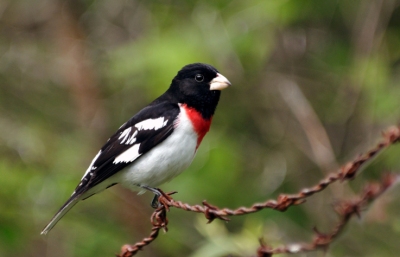Wherefore art thou red in thine apparel, and thy garments like him that treadeth in the winefat? (Isaiah 63:2 KJV)
Today, you are being introduced to the Cardinalidae Family, which is the last family, in taxonomy order, of the Passeriformes Order. Since February 1, 2016, we began the journey with the first four families in More Amazing Birds. Now we have arrived at the last of the 131 families of this order. I trust you have enjoyed the journey through these many Sundays. Hopefully you have been blessed by the great variety of Avian Wonders from our Lord, their Creator. The Passeriformes Order contains well over half of all the birds in the world; around 6,000 plus of the 10,659 species on the latest update. (6.3)
The Cardinalidae – Cardinals, Grosbeaks and allies has 69 species in the family. Because of that number, this family will be presented in two segments. Growing up in Indiana, the Northern Cardinal was a favorite of most of us. It is the “State Bird” of Indiana along with six other states. [Illinois, Kentucky, North Carolina, Ohio, Virginia, West Virginia] The family members are found in North and South America. The South America Cardinals of the genus Paroaria are placed in another family, the Thraupidae (previously placed in Emberizidae). Even though the family name is Cardinalidae, there are only two “cardinals” among the members.
Also known as cardinal-grosbeaks and cardinal-buntings, this family’s members “are robust, seed-eating birds with strong bills. The family ranges in size from the 12-cm (4.7-in), 11.5-g (0.40-oz) and up orange-breasted bunting to the 25-cm (9.8-in), 85-g (2.99-oz) black-headed saltator. They are typically associated with open woodland. The sexes usually have distinctive appearances. The northern cardinal type species was named by colonists for the male’s red crest, reminiscent of a Catholic cardinal’s biretta.
The ‘North American buntings’ are known as such to distinguish them from buntings. The name ‘cardinal-grosbeak’ can also apply to this family as a whole.”(Wikipedia)
The family starts off with 11 Tanagers in the Piranga genus, which used to be in with the tanagers, but were relocated here recently. “They are essentially red, orange or yellow all over, except the tail and wings and in some species also the back. Such extensive lipochrome coloration (except on the belly) is very rare in true tanagers, but is widespread among the Cardinalidae in the Piranga genus.
These songbirds are found high in tree canopies, and are not very gregarious in their breeding areas. Piranga species pick insects from leaves, or sometimes in flight. They will also take some fruit. Several species are migratory, breeding in North America and wintering in the tropics.”
Next are the Ant Tanagers in the Habia genus. “These are long-tailed and strong billed birds. The males have a red crest and plumage containing red, brown or sooty hues. Females may resemble the males or be largely yellowish or brown in colour.” Following these are four more tanagers in the Chlorothraupis genus. These are the last of the tanagers that were moved to this family.
The next genus, Pheucitcus has six Grosbeaks. Typical of the genus, they lay two to five pale bluish to greenish eggs with heavy brown and gray speckling. The cup nest is built at medium height in a bush or small tree.” (Wikipedia)
There are three Chats in the Granatellus genus; Red-breasted Chat, Grey-throated Chat, and the Rose-breasted Chat. They range from North America through Central America into northern South America. Their natural habitat is subtropical or tropical dry forests.
We will finish this first half of the family with three of my favorites, the Cardinalis genus. Our Northern and Vermilion Cardinals and the Pyrrholixia (which I saw for the first time last year) are hard to miss with their bright set of feathers the Lord provided for them. These range across North America and into northern South America.
“He answered and said unto them, When it is evening, ye say, It will be fair weather: for the sky is red.” (Matthew 16:2 KJV)
“Come now, and let us reason together, saith the LORD: though your sins be as scarlet, they shall be as white as snow; though they be red like crimson, they shall be as wool.” (Isaiah 1:18 KJV)
“Written in Red” – Faith Baptist Choir and Orchestra
For God so loved the world, that he gave his only begotten Son, that whosoever believeth in him should not perish, but have everlasting life. For God sent not his Son into the world to condemn the world; but that the world through him might be saved. He that believeth on him is not condemned: but he that believeth not is condemned already, because he hath not believed in the name of the only begotten Son of God. And this is the condemnation, that light is come into the world, and men loved darkness rather than light, because their deeds were evil. (John 3:16-19 KJV)
*
Sunday Inspiration – More Amazing Birds
Cardinalidae – Cardinals, Grosbeaks and allies
*






